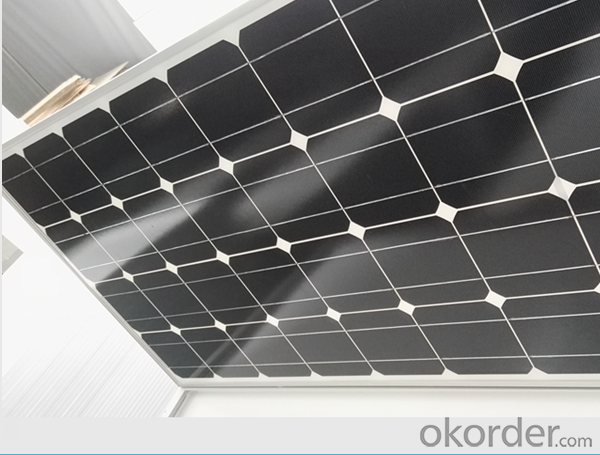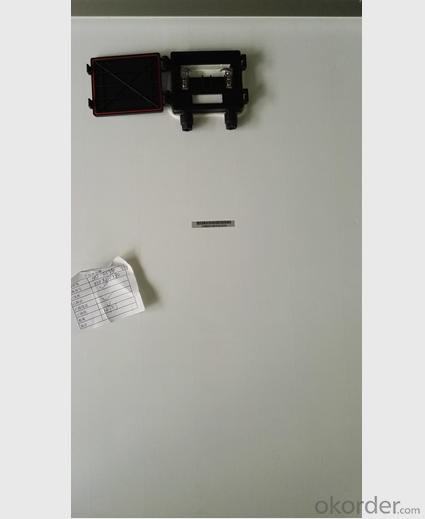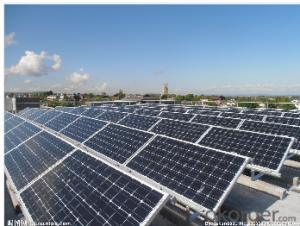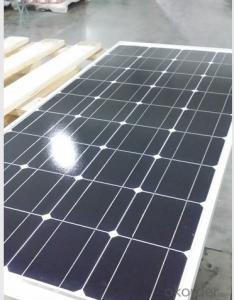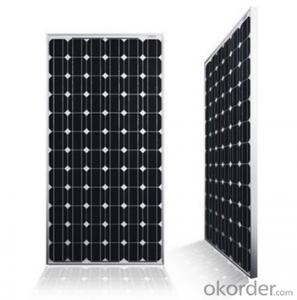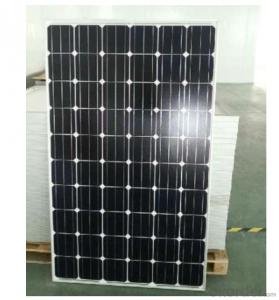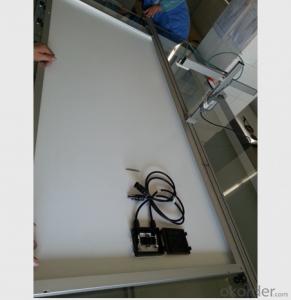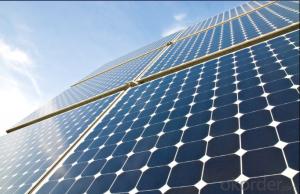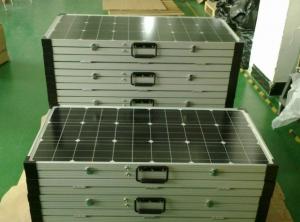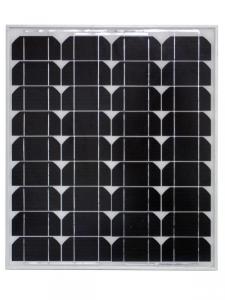Best Cheap Solar Panels - Monocrystalline Solar Panel CNPV-85W High Performance 36 Cell
- Loading Port:
- Shanghai
- Payment Terms:
- TT OR LC
- Min Order Qty:
- 25 pc
- Supply Capability:
- 100000 pc/month
OKorder Service Pledge
OKorder Financial Service
You Might Also Like
Product Description:
Solar Monocrystalline Series Panels
Introduction of Solar Monocrystalline Series Panels
CNBM Solar photovoltaic (PV) Panel is designed for large electrical power requirements. It is the optimal choice for both on-grid and off-grid power systems. CNBM Solar panel offers high performance of power per square foot of solar array. Monocrystalline silicon(c-Si): often made using the Czochralski process. Single-crystal wafer cells tend to be expensive, and because they are cut from cylindrical ingots, do not completely cover a square solar cell module without a substantial waste of refined silicon. Hence most c-Si panels have uncovered gaps at the four corners of the cells.
Standard Test Conditions of Solar Monocrystalline Series Panels
The opto-electrical specifications shown below are stabilized values being measured at Standard Test Conditions, Irradiance: 1000W/m2, Spectrum: AM1.5 at 25°C, The info below is subject to manufacturing tolerances. Where appropriate minutes of measurement are available and are used for the dimensioning of the installation.
Advantages of Solar Monocrystalline Series Panels
• Solar performance guarantees for 25 years
• 5 years guarantee for workmanship
• Timeliness of delivery
Characteristics of Solar Monocrystalline Series Panels
Max Power Voltage Vmp (V) | 17.6V |
Max Power Current Imp (A) | 4.82A |
Open Circuit Voltage Voc (V) | 22.3V |
Short Circuit Current Isc (A) | 5.56A |
Max Power Pm (W) | 85W |
Temperature Coefficient of Cells
NOCT | 47℃±2℃ |
Temperature Coefficients of Isc (%/℃) | 0.064 |
Temperature Coefficients of Voc (%/℃) | -0.33 |
Temperature Coefficients of Pmp (%/℃) | -0.45 |
Mechanical Data Solar Monocrystalline Series
Power | 85W |
Dimension | 1190×550×30mm |
Weight | 8kg |
Tolerance | ±3% |
The dimension of the modules can be changed according to the demand of clients
Limits
Operating Temperature | –40 °C to +85°C |
Storage Temperature | –40 °C to +85°C |
Max System Voltage | 700V |
Guarantee Solar Monocrystalline Series Panels
Products Guarantee | 5 yrs free from defects in materials and workmanship |
Performance Guarantee | No less than 90% within 10yrs and no less than 80% within 25yrs |
Certificates | UL, IEC, ISO, TUV, CE |
The Examination of Solar Monocrystalline Series Panels
FAQ
We have organized several common questions for our clients,may help you sincerely:
1. What’s price per watt?
A: It’s depends on the quantity, delivery date and payment terms of the order. We can talk further about the detail price issue.
2. Can you tell me the parameter of your solar panels?
We have different series of cells with different power output, both from c-si to a-si. Please take our specification sheet for your reference, or check the above data for your reference.
3. How do you pack your products?
We have rich experience on how to pack the panels to make sure the safety on shipment when it arrives at the destination.
Normally we put the panels in carton and then in pallets.
4. Can you do OEM for us?
Yes, we can. It will depend on the quantity.
5. How do you pack your products?
We have rich experience on how to pack the panels to make sure the safety on shipment when it arrives at the destination.
- Q: can anyone help me? i was thinking of installing solar panels to cut bills but would it be a waste considering its gonna need a circulating pump running almost 24/7 (which will use electricity) and even still will only provide me with quot;warmwater? also would it be possible to install the solar panels for the sole purpose of providing sufficient power to run electric heaters instead of using gas/oil? this way allowing me to have a warm house without the expensive bills. brobably talking about running 7 heaters/electric radiators.
- Are you thinking of installing electric solar panels or thermal solar panels or both? It would be better to install electric solar panels for electric heating. You can run 7 heaters as long as you do the calculations for the number of panels need for the daylight hours, and the required battery bank to supply the required power.
- Q: Can solar panels be used for air conditioning?
- Yes, solar panels can be used for air conditioning. By converting sunlight into electricity, solar panels can power air conditioning units, reducing reliance on the grid and providing a renewable energy solution for cooling purposes. However, the efficiency and capacity of solar panels may vary depending on factors such as the size of the system, available sunlight, and the energy demands of the air conditioning unit.
- Q: Can solar panels be installed on ground-mounted structures?
- Yes, solar panels can be installed on ground-mounted structures. Ground-mounted solar panel systems are commonly used when rooftops are not suitable for installation or when larger solar arrays are required.
- Q: Can solar panels be used for powering public transportation?
- Yes, solar panels can be used for powering public transportation. Solar-powered buses and trains are already in use in various cities around the world. These panels capture sunlight and convert it into electricity, which can be used to power the vehicles' motors, lighting, and other systems. This renewable energy source helps reduce carbon emissions and dependence on fossil fuels in the transportation sector.
- Q: I need to know how do solar panels work. I need to know what are they made of.
- The term solar panel is best applied to a flat solar thermal collector, such as a solar hot water or air panel used to heat water, air, or otherwise collect solar thermal energy. But 'solar panel' may also refer to a photovoltaic module which is an assembly of solar cells used to generate electricity. In all cases, the panels are typically flat, and are available in various heights and widths.
- Q: How are solar panels installed?
- Solar panels are typically installed on rooftops or open spaces using metal frames or mounting brackets. The process involves anchoring the panels securely, connecting them in a series or parallel configuration, and wiring them to an inverter that converts the DC electricity generated by the panels into usable AC electricity. Additionally, a solar panel installation may require making electrical connections to the building's electrical system and installing a net meter to measure the energy produced and consumed.
- Q: Can solar panels be installed on a small scale?
- Yes, solar panels can be installed on a small scale. In fact, they are highly adaptable and can be installed on rooftops, balconies, or even small plots of land. This makes them a convenient and cost-effective solution for individuals or small businesses looking to generate their own renewable energy.
- Q: How do solar panels affect the property's energy management strategy?
- Solar panels can have a significant impact on a property's energy management strategy. By harnessing the sun's energy, solar panels generate clean and renewable electricity, reducing the property's dependence on traditional power sources. This can lead to lower energy costs, increased energy independence, and a reduced carbon footprint. Solar panels also provide a stable and reliable source of energy, allowing for better energy planning and management. Additionally, excess energy generated by solar panels can be stored or sold back to the grid, providing additional financial benefits. Overall, solar panels play a crucial role in shaping and optimizing a property's energy management strategy.
- Q: Can solar panels be used for powering agricultural irrigation systems?
- Yes, solar panels can be used to power agricultural irrigation systems. Solar-powered irrigation systems are increasingly being used in agriculture as they provide a sustainable and cost-effective solution. Solar panels convert sunlight into electricity, which can then be used to power pumps and other irrigation equipment, reducing reliance on fossil fuels and electricity grids. This approach helps farmers save on energy costs and reduces their carbon footprint.
- Q: I have two solar panels and I have measured that they produce V by themselves. I am trying to generate .5V, but whenever I hook them up in parallel I get something like .02V. What it happening?
- You are probably wiring them incorrectly: with the positive on panel A connected to negative on panel B; and the negative on panel A connected to the positive on panel B. If you want then connected in parallel, connect the positive on panel A to the positive on panel B and the negative on panel A connected to the negative on panel B. But you will only get vdc. You can't get .5 volts from two volt sources. You can get 2 volts by connecting the panels in series.
Send your message to us
Best Cheap Solar Panels - Monocrystalline Solar Panel CNPV-85W High Performance 36 Cell
- Loading Port:
- Shanghai
- Payment Terms:
- TT OR LC
- Min Order Qty:
- 25 pc
- Supply Capability:
- 100000 pc/month
OKorder Service Pledge
OKorder Financial Service
Similar products
Hot products
Hot Searches
Related keywords


